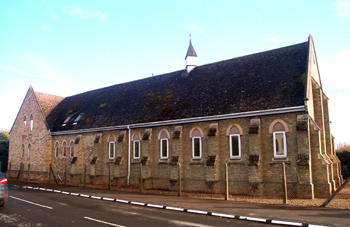Methodists in Willington

The Methodist Chapel from Station Road February 2010
By far the best represented nonconformist group in records held by Bedfordshire & Luton Archives & Records Service are the Wesleyans Methodists. The first surviving registration of a meeting by them is 1823 when they met in the house of John Robinson and the registration was carried out by the minister, Aquila Barber [ABN1/2, ABN2/202, ABN3/3 and ABN3/51]. The chapel was built and was first registered in 1868 by John Relph, the Wesleyan minister of the Bedford Circuit. It was registered to conduct marriages in 1869.
Bedfordshire & Luton Archives & Records Service has notes compiled by staff on the Willington chapel [CRT130WILL3] from which it appears that the first time Methodists in Willington are mentioned in the Bedford Circuit book was in 1804, those referred to being: Thomas Thordy; Mary Thordy; Sarah Robinson; James Roberts; Thomas Penwright; Ann King and John Kendall. Although, as noted above, a meeting was registered in 1823, Willington nowhere appears in the list of churches taking collections for various causes between 1820 and 1841. From 1842 Willington givers are bracketed with those from Cardington despite the fact that Willington had quite a flourishing little chapel. This is proved by the return for the Ecclesiastical Census of 1851.
The secular authorities wished to know how many people in the country attended worship and the rough proportions for each denomination. Thus a census of worshippers was held on Sunday 30th March 1851. It was not a particularly popular exercise and the day itself, cold, wet and unpleasant, did not exactly encourage people to go outdoors. Nevertheless, Thomas Twitchell reported that there had been forty people attending morning service in a chapel with seats for fifty and that this was about average. Cardington, however, was clearly a larger meeting as it had seats for nearly 150 and had more tha that number attending that morning.
The chapel built in 1868 was first mooted in 1860 when the circuit gave leave for it to be built, subject to the landowner, the Duke of Bedford, giving the land. By 1864 the Methodist cause in Willington had around 20 members and in 1867 once more the circuit gave leave to erect a chapel if the Duke would grant a site. When he did so, the following year, the Duke stipulated that he would not sell land for the site but would grant one provided the chapel was only built of wood or iron.
![Plans showing the west elevation of the Methodist chapel in 1987 [PCWillington18/22]](/CommunityHistories/Willington/WillingtonImages/PCWillington18-22 west elevation 1987_350x260.jpg)
Plans showing the west elevation of the Methodist chapel in 1987 [PCWillington18/22]
That chapel was in Station Road on the site of modern council houses. Later in the century it was moved across the road, on rollers, and encased in brick, giving the core of building which stands today. In 1986 the chapel was extended as the image , taken from the plans [PCWillington18/22], shows.

The Methodist Church from Chapel Lane February 2010
In 1932 the Wesleyan Methodists joined with the Primitive Methodists and United Methodists in creating The Methodist Church of Great Britain. At the time of writing [2010] the Methodist chapel remains a place of worship. The building is also used by other village groups as a place in which to hold meetings.